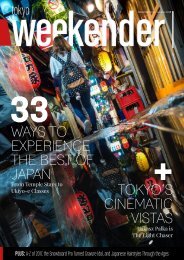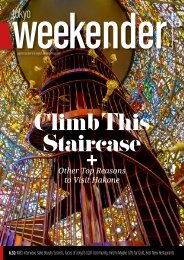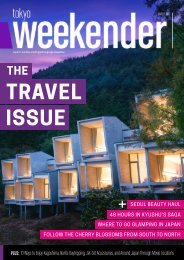Tokyo Weekender - November 2017
Our November issue is out, featuring a jam-packed end-of-year special: 42 Christmas gift shopping ideas and 10 bonenkai spots. Plus: The avant-garde world of butoh dance, Japanese teen prodigies, and a special supplement guide to Akita. Here's where to find a copy around Tokyo: www.tokyoweekender.com/pickup/
Our November issue is out, featuring a jam-packed end-of-year special: 42 Christmas gift shopping ideas and 10 bonenkai spots. Plus: The avant-garde world of butoh dance, Japanese teen prodigies, and a special supplement guide to Akita. Here's where to find a copy around Tokyo: www.tokyoweekender.com/pickup/
Create successful ePaper yourself
Turn your PDF publications into a flip-book with our unique Google optimized e-Paper software.
[ PROMOTION ]<br />
around the spectacular Geibikei (Geibi Gorge)<br />
is fascinating in any season, though autumn<br />
is the most delightful time to visit. The nearby<br />
Genbikei is a humbler gorge, but pleasant<br />
nonetheless. Whilst in the area a visit to the<br />
town of Hiraizumi is a must. As Tohoku's first<br />
UNESCO World Heritage Site, it features some<br />
of the region's most precious historic and<br />
cultural properties. The Sanriku Coast should<br />
also be explored. Along the way, stop off at<br />
the impressive cliffs of Kitayamazaki and<br />
relax near the iconic rocks of Jodogahama<br />
Beach.<br />
FUKUSHIMA<br />
Unfortunately, due to the nuclear crisis, many<br />
are still reluctant to go to Fukushima, yet the<br />
vast majority of this delightful prefecture is<br />
perfectly fine and open for business as usual.<br />
The no-entry zone around Fukushima Daiichi<br />
Nuclear Power Plant makes up less than<br />
three percent of the area, while the rest of the<br />
5,320-square-mile region has been deemed<br />
safe so tourists can wander around without<br />
fear. Those concerned about food grown in<br />
the prefecture can experience the Study Farm<br />
in Nihonmatsu and speak with local farmers.<br />
With around 135 onsen in total, Fukushima<br />
is known as a hot spring haven. Some<br />
of the surrounding scenery is majestic, especially<br />
landscapes shaped by past volcanic activity.<br />
A prime example is Mt. Bandai, which<br />
last erupted in 1888. It led to the creation of a<br />
cluster of five lakes known as Goshikinuma,<br />
each of which has its own delicate<br />
color ranging from cobalt blue to reddish<br />
green. The imposing mountain overlooks<br />
the samurai town of Aizu-Wakamatsu which<br />
boasts a rich warrior history dating back<br />
more than 1,000 years. The town's main attraction<br />
is Tsuruga Castle, a concrete replica<br />
of the Kurokawa Castle built in 1384.<br />
YAMAGATA<br />
Another prefecture famed for its hot<br />
springs, Yamagata is a pleasant place to visit<br />
all year round. However, it is especially<br />
popular in the early part of the summer<br />
when people go to pick cherries, and in<br />
winter when many tourists hit the slopes.<br />
One of the most picturesque locations is<br />
Zao Onsen, a well-known ski and hot spring<br />
resort where you can see ice trees that are<br />
known as snow monsters. The best time to<br />
view them is in the evening from a café at<br />
the summit when they are lit up.<br />
After a long day skiing or snowboarding,<br />
it's also nice to take a dip in one of Zao's<br />
relaxing hot spring baths. While not as<br />
famous as the secluded onsen town of Ginzan,<br />
the water in the area is among the most<br />
acidic in the country with a pH value of<br />
close to one. Zao's main and most dazzling<br />
attraction is the teal-hued crater lake on the<br />
mountain bordering Yamagata and Miyagi<br />
known as "Okama" (bowl), which simply put<br />
is one of the most spectacular spots in all of<br />
Japan. Other eye-catching locations in the<br />
prefecture include the revered religious site<br />
of Dewa Sanzan in Mount Haguro and Risshaku-ji,<br />
a mountain temple with stunning<br />
views of Yamagata City.<br />
AOMORI<br />
The northernmost prefecture in Honshu,<br />
Aomori is known for its abundance of<br />
natural beauty and delightful water. Nowhere<br />
is this more evident than at Oirase<br />
Mountain Stream where you can see almost<br />
30 crystal clear cascading waterfalls within<br />
a 14-kilometer hike through the deciduous<br />
forest. Designated a special scenic spot and<br />
natural monument of the prefecture, it's one<br />
of Tohoku's most alluring sites. Be warned<br />
though, it can get crowded in autumn due to<br />
the dazzling foliage colors.<br />
Connected to Oirase Stream is Lake Towada,<br />
the largest caldera lake in Honshu, where<br />
the water is so translucent you can see down<br />
for 10 meters. Other well-known sites in Aomori<br />
worth going to are Hirosaki Castle, especially<br />
during spring when thousands of cherry<br />
trees are in bloom, and Sannai-Maruyama, a<br />
Jomon period archaeological site discovered<br />
by accident while surveying land to build a<br />
community baseball field. The most exciting<br />
time to visit the prefecture is early in August<br />
when the country's largest Nebuta Festival<br />
takes place. Nebuta refers to the float of a<br />
warrior figure that's carried through the city.<br />
If you can't make it in the summer, the next<br />
best option is to visit the Nebuta Warasse<br />
Museum featuring all kinds of memorabilia<br />
from the festival's 300-year history.<br />
AKITA<br />
When it comes to tourism, Akita feels relatively<br />
untouched compared to the country's<br />
more glamorous prefectures, and this is part<br />
of the region's charm. It's a great opportunity<br />
to escape the large crowds and enjoy the<br />
attractive natural wonders on view such as<br />
Lake Tazawa and the beech forest of Nyuto<br />
Village featuring seven hot spring baths,<br />
each with their own water source. The most<br />
famous site in the area is Shirakami-Sanchi,<br />
a vast mountain range that straddles both<br />
Akita and Aomori. There are numerous<br />
scenic treasures along the way including the<br />
mesmerizing sapphire-blue pond.<br />
Winters can be quite harsh in Akita,<br />
but don't let that put you off. For many,<br />
it's the best time to be there as there are<br />
many intriguing festivals. A ritual known as<br />
Namahage, in which men dressed as ogrelike<br />
figures descend from the mountains<br />
with drums and torches looking for naughty<br />
children, takes place at the end of the year.<br />
In mid-February the city of Yokote is taken<br />
over by igloos for the 400-year-old Kamakura<br />
Snow Festival. Around the same time the Hiburi<br />
Kamakura Fire-spinning Festival is held<br />
in the samurai town of Kakunodate.<br />
(For even more things to do in Akita, check out<br />
our supplement guide, included in this issue.)<br />
TOKYO WEEKENDER | NOVEMBER <strong>2017</strong> | 45
















